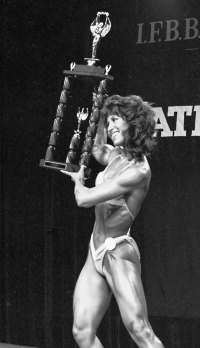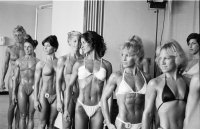The advances women, especially in Western culture, have made since the second half of the 19th century are astounding. This becomes particularly clear when you look at parts of the world that have not undergone this evolutionary change. For example, when they are denied education, freedom of movement and even the right to drive.
In the western world, including the US, women could not own property in the not too distant past. They were considered the property of their husbands. It wasn't until 100 years ago, not in ancient history, that most women in America got the right to vote.
In modern culture, feminism advocates women's rights and equality, but it seems that some women who should benefit from this type of advocacy have been left behind by the movement. In particular, women with muscles who exercise and feed themselves to create aesthetic bodies and who participate in muscle competitions in different categories - especially female bodybuilders.
Women are traditionally considered to be the “weaker” sex. Eventually, in the 20th century, they were increasingly celebrated in athletics, and many sports for women are more popular today than the same sport for men. From the 1970s, women began to compete in bodybuilding as well.
The 1980s Ms. Olympia lineup Bill Dobbins
However, in the 1970s, this movement bumped against a wall, failing to acknowledge or respond to the gradually increasing discrimination against competitors in the emerging sport of bodybuilding for women.
Of course, it is not the overall idea of muscles in women that provokes this type of opposition. Throughout history, most of the people, including women, have been farmers. In the days before mechanized farm machinery, muscle was what did the job. body has ever criticized peasant women for having the strength to plow behind a mule, fetch water, or chop wood.
There is also no general opposition based on women growing tall and strong. Strong women with muscles have long been celebrated in comics. Female wrestlers have become stars in this world. Olympic weightlifting and powerlifting competitions for women have been around for decades. However, because their bodies are geared towards athletic performance rather than aesthetics, they are accepted.
Football player-turned-player Fred Dryer told me when he joined the NFL in the 1960s that almost no players trained with weights. But when he left in the 1970s, everyone did. Baseball used to be mainly considered a sport of skill. But modern batters who do strength training are setting all kinds of records.
In this context, also take a look at the female sprinters at the Olympic Games in the 100-meter run. They all look like miniature bodybuilders, no doubt because of the time they spend in the weight room. Or check out the size and strength of Serena Williams, a woman who is rarely criticized for her muscles. At the 2015 Open, Serena Williams hit a serve of 126 mph. That was 1 km / h faster than the fastest serve of the master master vak Djokovic. You can't get that strength without a lot of strength training.
Even so, our culture accepts muscles and muscles much more for male bodybuilders than for women. It is largely based on a long historical tradition, ranging from the sculptures of Ancient Greece and Michelangelo to the strong men of the 19th century and decades of muscle films with Steve Reeves. Arnold Schwarzenegger, Sly Stallone and others.
Pumping Iron writer Charles Gaines has called modern female bodybuilders a "new archetype," something that has not existed in any culture at any point in history. Something really "new under the sun".
With something so unique, it takes a long time for the world to get used to the idea. As women grew taller and more muscular over the decades, resistance to bodybuilding for women continued to grow and become stronger.
Pioneers like Lisa Lyon, Rachel McLish, and Cory Everson had little muscle compared to today's female bodybuilders, even when compared to fitness and figure competitors. They mostly had a lot of definitions generated by extreme diet. At the time, they were considered "cute" and received a lot of media attention.
Competitions such as the IFBB Frau Olympia and Arnold's Frau International were successful and well attended early on. The women were featured frequently in the major bodybuilding magazines.
Lisa Lyon was the first female bodybuilder to receive national attention. She was on TV, starred in Playboy, and was working on a book with photographer Robert Mapplethrope. Corey Everson had her own cable television program and appeared in a film with Jean-Claude Van Damme. Rachel McLish starred in several feature films.
 Rachel McLish, the first woman Olympia Bill Dobbins
Rachel McLish, the first woman Olympia Bill Dobbins
But while everyone loves kittens, many don't like cats.
As women got bigger and more muscular (as happens when genetically gifted athletes train hard and long enough), resistance to them continued to increase. This opposition often took the form of blatant and explicit discrimination based on sex, sometimes emanating from the government bodies themselves, often in the form of rules that would not have been tolerated in any other sport and may not have been legal. Can you think of a rule in bodybuilding for men that says competitors can't be "too big" or "too muscular"?
One such rule was enacted by the IFBB in a series of "Guidelines" from 2000 for women.
These guidelines have been issued to female bodybuilders by both the NPC and the IFBB. These guidelines limited muscle “to the limit” for women, but not men, and were a clear example of gender discrimination. The result was a series of competitions that, in retrospect, were judged very unfairly.
The only limit to becoming competitive women bodybuilders, other than the need to adhere to size or weight distribution requirements, should be aesthetic - the aesthetic is that of bodybuilding, not some other more conventional measure of "beauty". ”
But you have to wonder where the feminists have been when this fundamental right of women to control their own bodies is being challenged. Why have they not spoken out against such a blatant case of institutional gender discrimination and the disregard for women's right to perform at the highest level in relation to the aesthetic development of their own bodies? Was this topic dealt with by a women's rights organization?
And yet there is still resistance in our culture to women who develop their muscles for aesthetic reasons. When was the last time you saw a professional bodybuilder on Good Morning America? What does the mainstream find so terribly strange about women who build big, full, shapely, and defined muscles? Sure, most women don't aspire to a professional bodybuilding body. But neither did the millions of fans of Arnold Schwarzenegger or Serena Willams.
The situation for professional female bodybuilders at IFBB has improved tremendously since Jake Wood and Wings of Strength became involved. There has been little evidence of anti-muscle judgment from officials, and bodybuilding for women has returned to the Olympics. Every year there are more pro competitions for female bodybuilders.
But feminist organizations have never advocated helping women bodybuilders where and when they have been victims of disrespect and gender bias. And these days the female bodybuilders at IFBB and NPC don't really need your help.
Still, perhaps these organizations should take a look at their mission statements and find out why women bodybuilders have never thought about them.

